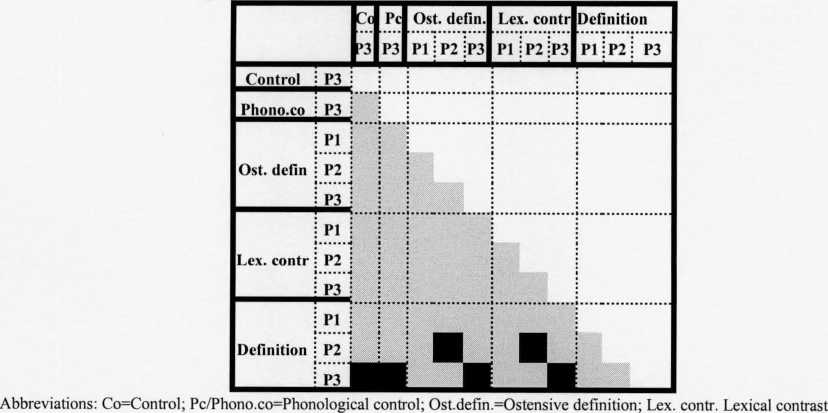Significant differences were found for post test 2 [F(2,75)=30.5, p<.0000] and post test 3
[F(4,125)=19.02, p<.0000] but not for post test 1. Table 7.13 presents the means by group
across testing.
Table 7.13 Performance (means and sds) in the “categorisation questions” by group
across testing
|
______________________________Post test 1______ |
Post test 2______ |
Post test 3 | ||||
|
Mean (sd) |
___Mean |
(sd) |
Mean |
(sd) | ||
|
Control |
'~ .62 |
(.98) | ||||
|
Pho.Control |
.69 |
(∙93) | ||||
|
Ostensive definition |
.54 |
(-76) |
.69 |
(97) |
1.19 |
(1-Ю) |
|
Lexical Contrast |
.54 |
(■71) |
.77 |
(■95) |
1.12 |
(1∙24) |
|
Definition______________ |
.50 |
(∙76) |
2,73 |
(1∙25) |
2.92 |
(l∙20) |
Post-hoc analysis for post test 2 revealed that the Definition group performed significantly
better than the Ostensive definition and Lexical contrast group. Post-hoc analysis for post test
3 revealed that the Definition group performed significantly better than all the other groups.
Diagram 7.5 demonstrates the significant differences between the groups across testing.
Diagram 7.5 Significant group differences in the “categorisation questions” across
testing

Word knowledge questions
Three Kruskal-Wallis I-Way Anovas were carried out with group as the independent factor
and score on the questions as the dependent factor. Children’s performance in the “world
228
More intriguing information
1. Macroeconomic Interdependence in a Two-Country DSGE Model under Diverging Interest-Rate Rules2. The name is absent
3. The East Asian banking sector—overweight?
4. GROWTH, UNEMPLOYMENT AND THE WAGE SETTING PROCESS.
5. The name is absent
6. The name is absent
7. The name is absent
8. The name is absent
9. The name is absent
10. Sex-gender-sexuality: how sex, gender, and sexuality constellations are constituted in secondary schools